
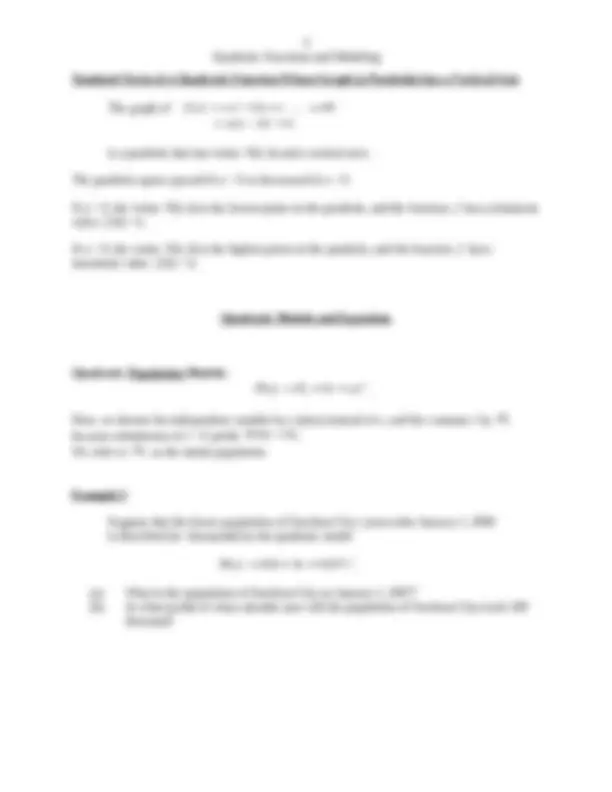
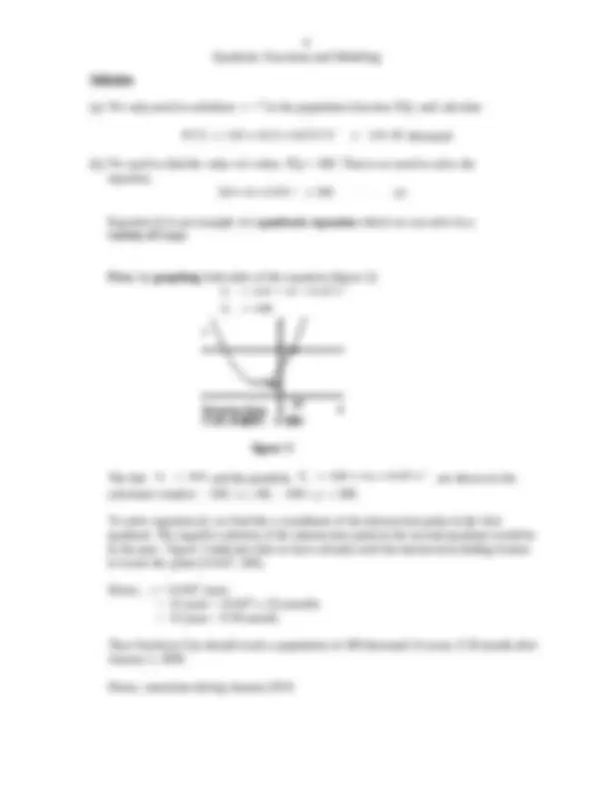
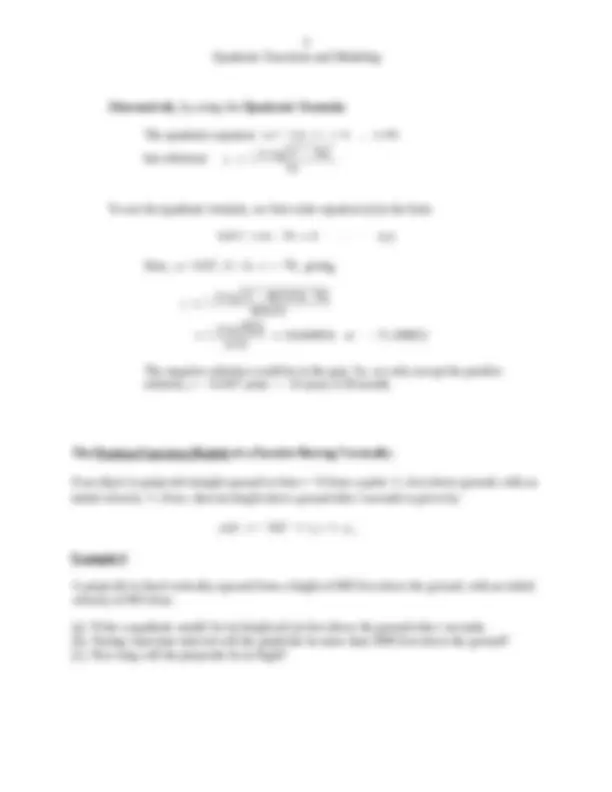
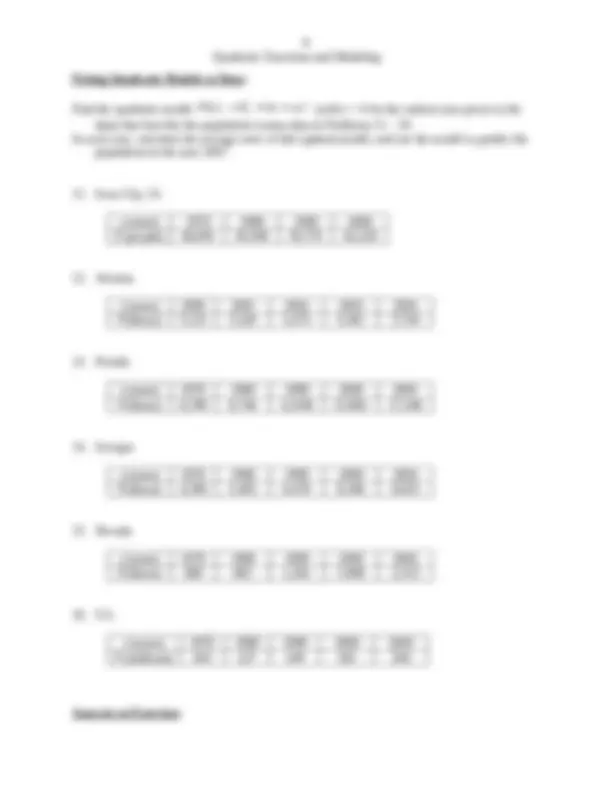
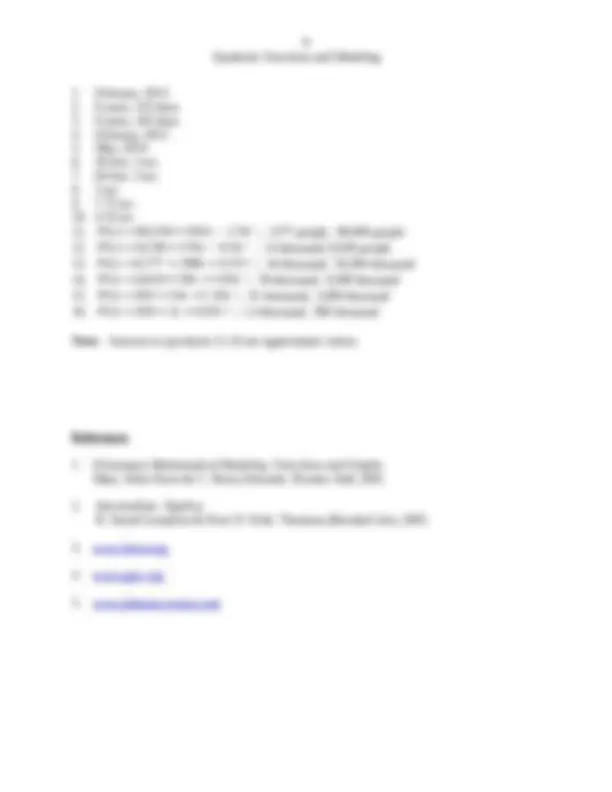


Study with the several resources on Docsity

Earn points by helping other students or get them with a premium plan


Prepare for your exams
Study with the several resources on Docsity

Earn points to download
Earn points by helping other students or get them with a premium plan
Community
Ask the community for help and clear up your study doubts
Discover the best universities in your country according to Docsity users
Free resources
Download our free guides on studying techniques, anxiety management strategies, and thesis advice from Docsity tutors
An introduction to quadratic functions and their applications in modeling the trajectory of an object near the earth's surface when only gravitational attraction is present. The definition of quadratic functions, their graphs, and the standard form of a quadratic function. It also discusses quadratic population models and their equations, as well as examples of solving quadratic equations using graphing and the quadratic formula.
Typology: Study notes
1 / 9

This page cannot be seen from the preview
Don't miss anything!






MATH 1001 (Quantitative Skills and Reasoning) Gordon College, Barnesville, GA. Quadratic Functions and Modeling In this unit, we will study quadratic functions and the relationships for which they provide suitable models. An important application of such functions is to describe the trajectory, or path, of an object near the surface of the earth when the only force acting on the object is gravitational attraction. What happens when you toss a ball straight up into the air? What about an outfielder on a baseball team throwing a ball into the infield? If air resistance and outside forces are negligible, what is the mathematical model for the relationship between time and height of the ball? Definition: Quadratic Functions A quadratic function is one of the form f ( x ) ax^2 bx c , where a , b , and c are real numbers with a ≠ 0. The graph of a quadratic function is called a parabola and its shape resembles that of the graph in each of the following two examples. Example 1 Figure 1 shows the graph of the quadratic function y f ( x ) x^2 4 x (^1). figure 1 Observe that there is a lowest point V (2, −3) on the graph in figure 1. The point V is called the vertex of the parabola.
Quadratic Functions and Modeling Example 2 Figure 2 shows the graph of the quadratic function y g ( x ) 2 x^2 4 x 3. figure 2 Again, observe that there is a highest point V (1, 5) on the graph in figure 2. This point V is also the vertex of the parabola. By completing the square , the quadratic function (example 1) f^ (^ x ) ^ x^2 ^4 x ^1 can be written as f ( x ) ( x 2 )^2 (^3) ; the quadratic function (example 2) (^ )^243 g x x^2 x can be written as g ( x ) 2 ( x 1 )^2 (^5). Note that the parabola in example 1 opens upward, with vertex V (2, −3) and a vertical axis of symmetry x = 2. The parabola in example 2 opens downward with vertex V (1, 5) and a vertical axis of symmetry x = 1.
Quadratic Functions and Modeling Solution (a) We only need to substitute t = 7 in the population function P ( t ) and calculate P ( 7 ) 110 4 ( 7 ) 0. 07 ( 7 )^2 141. (^43) thousand. (b) We need to find the value of t when P ( t ) = 180. That is we need to solve the equation, 110 4 t 0. 07 t^2 180 (i ) Equation (i) is an example of a quadratic equation which we can solve in a variety of ways. First , by graphing both sides of the equation (figure 3): 180 110 4 0. 07 2 2 1 Y Y t t figure 3 The line Y 2^ ^180 and the parabola 2 Y 1 (^) 110 4 x 0. 07 x are shown in the calculator window −100 ≤ x ≤ 80, −100 ≤ y ≤ 300. To solve equation (i), we find the x -coordinate of the intersection point in the first quadrant. The negative solution of the intersection point in the second quadrant would be in the past. Figure 3 indicates that we have already used the intersection-finding feature to locate the point (14.047, 180). Hence, t = 14.047 years = 14 years + (0.047 x 12) months = 14 years + 0.56 month. Thus Stockton City should reach a population of 180 thousand 14 years, 0.56 month after January 1, 2000. Hence, sometime during January 2014.
Quadratic Functions and Modeling Alternatively , by using the Quadratic Formula: The quadratic equation ax^2 ^ bx c ^0 , a ^0 has solutions a b b ac x 2 ^2 4 . To use the quadratic formula, we first write equation (i) in the form
Quadratic Functions and Modeling
Quadratic Functions and Modeling Fitting Quadratic Models to Data: Find the quadratic model 2 P ( t ) P 0 bt at (with t = 0 for the earliest year given in the data) that best fits the population census data in Problems 11 – 16. In each case, calculate the average error of this optimal model, and use the model to predict the population in the year 2007.